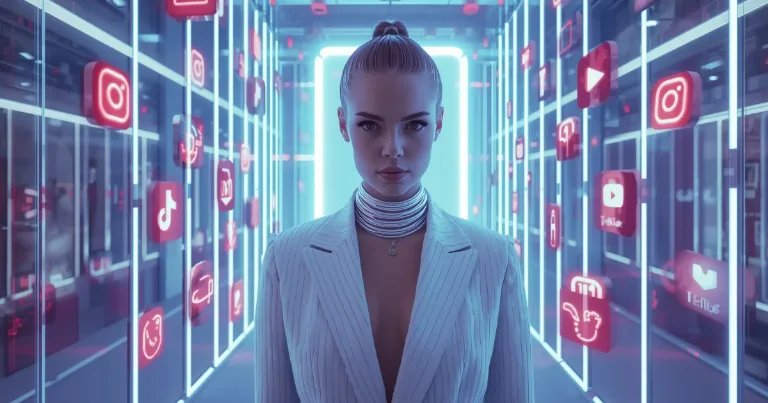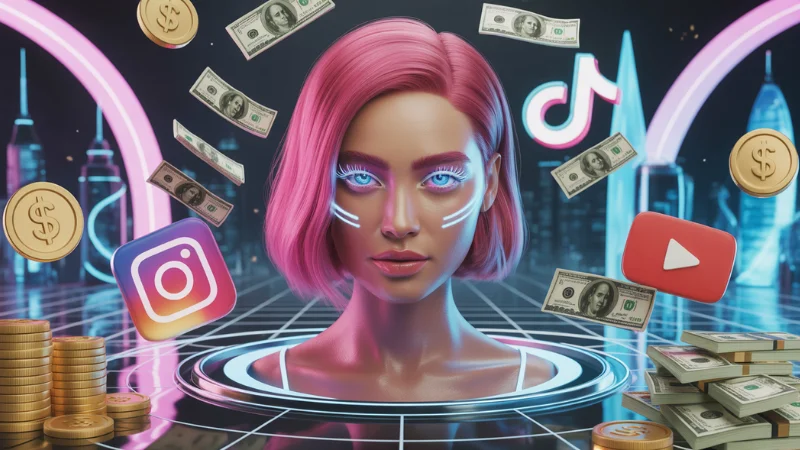The Secret Business of AI Influencers

I still remember the first time I saw an AI influencer on Instagram. At first glance, she looked like any other creator posting selfies, hanging out in cool spots, and dropping casual captions. Then I realized she was not real. Not a person. Just pixels, generated with AI.
That is when it hit me. People are actually building entire online businesses around influencers who do not even exist. And the crazy part is that brands are paying them real money. Prada, Samsung, Louis Vuitton. They are all in on it.
So what is the deal? How does this actually work, and why are companies willing to pay digital characters like they are celebrities? Let’s break down the secret business behind AI influencers.
What Are AI Influencers
An AI influencer is basically a digital character built to act like a real person online. They have names, personalities, backstories, and social media accounts where they post just like any other creator. The difference is that everything about them is artificial. Their faces are generated with AI tools, their posts are designed by a team or an individual, and even their “opinions” are scripted.
Some look obviously digital, almost like video game characters. Others are so realistic that you would not know they are fake unless someone told you. Either way, the goal is the same. Get people to follow them, engage with their content, and treat them as if they are real influencers.
It sounds strange at first, but once you scroll through their profiles, it starts to feel pretty normal. That is what makes the idea so powerful.
Why They’re Getting Big Attention

Brands love AI influencers for one simple reason. Control. A digital character will never show up late to a photoshoot, post something offensive, or get caught in a scandal. Every picture, every caption, every move can be perfectly managed.
There is also the novelty factor. People are curious. Seeing a digital character hanging out at the beach or promoting a new phone feels strange but also interesting. That curiosity pulls in followers, and followers are what brands want.
Cost plays a role too. Once the character is created, content can be generated quickly without paying for travel, makeup, or a production crew. Some companies see it as cheaper and more reliable than working with human influencers.
Add to that the fact that AI influencers are available 24/7, and you can see why big names in fashion, tech, and lifestyle are already experimenting with them.
How AI Influencers Are Created

Making an AI influencer is not just pressing a button. It is closer to creating a character for a story and then managing them like a real online creator.
Here are the main steps:
1. Pick a Niche and Audience
Decide what the influencer will focus on. Fashion, fitness, gaming, or lifestyle. A clear niche makes content easier to plan and followers easier to attract.
2. Build a Persona
Give the character:
-
A name
-
A personality
-
A backstory or lifestyle
People connect better when the influencer feels like someone with traits and preferences, not just a face.
3. Design the Visuals
AI image and video tools generate faces, outfits, and scenes. The most important part is consistency. If the influencer looks different in every post, people lose interest.
4. Keep the Character Consistent
-
Appearance: same face, hair, and style across posts
-
Branding: outfits, lighting, and colors follow a set theme
-
Voice: captions and replies match the same tone
Consistency makes the character recognizable and believable.
5. Use the Right Tools
There are thousands of AI tools available, but some popular ones for creating influencers are:
-
Creatify – generate realistic influencer photos
-
HeyGen – create video avatars with voice
-
Captions – design short video clips with avatars and text
-
Artbreeder – experiment with different faces and looks
These tools help keep the influencer polished and uniform across platforms.
6. Launch and Refine
Once the character is ready:
-
Open accounts on Instagram, TikTok, or YouTube
-
Post regularly so the character feels alive
-
Adjust visuals and personality based on what gets the most engagement
Monetization: How They Make Money

AI influencers might be digital, but the money they bring in is very real. Once a character builds a following, there are a number of paths to income. Some are more public and mainstream, others more private and sensitive.
-
Brand Sponsorships
Companies pay for posts, collaborations, promotions. As usual in marketing. -
Affiliate Marketing
Earning a cut when followers buy things through links. -
Ad Revenue on Major Platforms
Video content on YouTube, TikTok, etc., where views generate money if content meets the platform’s rules. -
Digital Products & Merchandise
E-books, wallpapers, designs, branded goods. -
Paid Subscription / Exclusive Content
Private or members-only content. This can include non-explicit premium content or suggestive content depending on platform rules. -
Adult / NSFW Subscription Models (If Allowed & Legal in Your Area)
Some AI influencers use subscription platforms known for adult or NSFW content to offer more private or explicit visuals. If doing this, creators often need to follow strict platform rules, age verification, and content labeling.
Pros and Challenges
Like any online business, AI influencers come with upsides and downsides. Knowing both is important before thinking about it as a side hustle.
Pros
-
Full control. Everything the influencer says or does is managed. No risk of scandals or unpredictable behavior.
-
Cost efficiency. After the setup, content can be produced at scale without paying for studios, travel, or makeup.
-
Always available. A digital character never sleeps. They can “post” and “engage” at any time.
-
Creative freedom. You can design an influencer to fit any niche, style, or brand vision.
-
Scalability. One person (or a small team) can manage multiple influencers at once.
Challenges
-
Authenticity questions. Not everyone feels comfortable engaging with something that is not real. Some people prefer human influencers.
-
Platform risks. Social media rules change often, and AI-generated content can get flagged.
-
Engagement limits. Building trust and emotional connection is harder with a fictional character.
-
High startup effort. You need to learn tools, build a style guide, and plan a lot before launching.
-
Ethical concerns. Some audiences or brands might see AI influencers as misleading or problematic, especially when they blend too closely with reality.
Is It Realistic for a Side Hustler?
The idea of creating an influencer who never ages, never complains, and never takes a day off sounds almost too good to be true. But is it actually something a regular person can do on the side?
The short answer is yes, but it depends on your goals.
-
Low barrier to entry. Many AI tools are easy to use, even without design skills. You can generate images, write captions, and post content with little upfront cost.
-
Time investment. To grow an audience, you still need consistency. Posting once a week will not build traction. Treating it like a real influencer account means planning content, writing captions, and engaging daily.
-
Scaling potential. With enough time and strategy, one person can run multiple AI influencers at once. That means you could test different niches and see which one gains traction.
-
Costs. While basic tools are affordable, the best ones for realistic visuals, video, and voice often come with subscription fees. Expect ongoing expenses if you want quality.
-
Skills. It helps to understand social media growth, marketing, and storytelling. The AI can generate content, but the human behind it needs to know how to build a following.
For someone looking for a unique side hustle, AI influencers can be realistic. But it is not a push-button money machine. It is closer to running a small content business, with all the work that comes with it.
Future Trends and What to Watch
AI influencers are still new, but the space is moving fast. What feels experimental today could be normal tomorrow. Here are some trends worth paying attention to:
-
More realism. AI visuals are improving quickly. Soon it may be almost impossible to tell an AI influencer apart from a real person.
-
Interactive experiences. Instead of just posts, AI influencers may chat with followers in real time using chatbots or voice AI, making them feel more personal.
-
Expansion into new niches. Right now most focus on fashion and lifestyle, but expect influencers in gaming, travel, fitness, and even education.
-
Regulation and labeling. Governments and platforms may require AI influencers to be clearly identified as artificial, to avoid misleading audiences.
-
Competition. As more people jump in, the market could get crowded. Standing out will require strong storytelling, not just pretty pictures.
-
Integration with the metaverse. Virtual reality and augmented reality could make these influencers even more lifelike, showing up at events or in digital worlds.
The space is still wide open, but also unpredictable. What works today might change quickly as tools evolve and rules tighten.
Opportunity or Illusion?
AI influencers show how fast the online world is changing. Characters that are not even real are building audiences, landing brand deals, and making money. The technology is moving quickly, and the business models around it are already proven.
For side hustlers, the opportunity is there. The tools are accessible, and you do not need a full team to start. At the same time, this is not effortless. Growing a digital persona takes planning, consistency, and patience, just like running any online brand.
The question is not whether AI influencers work. They do. The question is whether you are ready to put in the time to make one succeed.
About the author
Alex David Du
I’m Alex. I’m 28, born in Brazil, studied computer science, and writing is how I communicate best. I cover gaming, tech, simple ways to make money online, and other things I find interesting. I also love coding and building projects that bring ideas to life.
- Languages
- Portuguese, English
- Work Mode
- Freelancer - Remote
- Country
- Brazil
- hello@byalexdavid.com